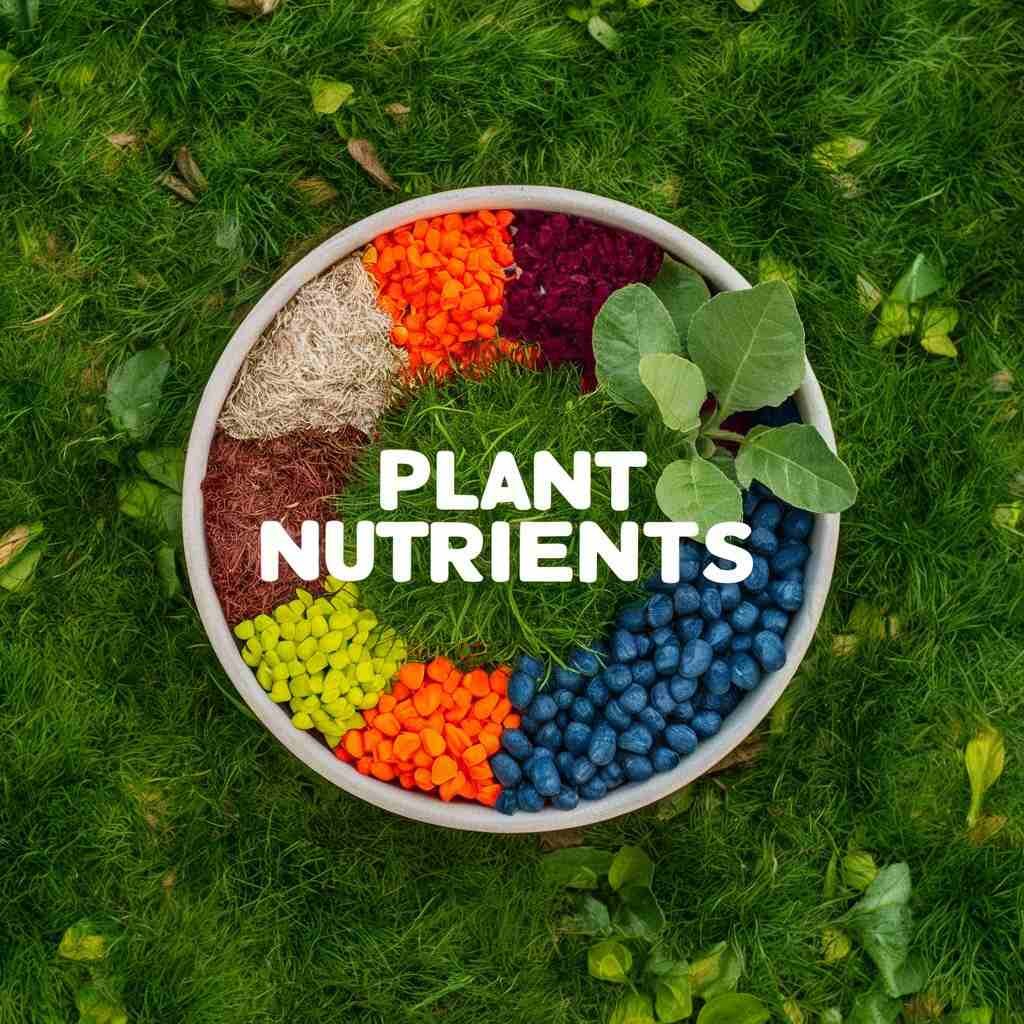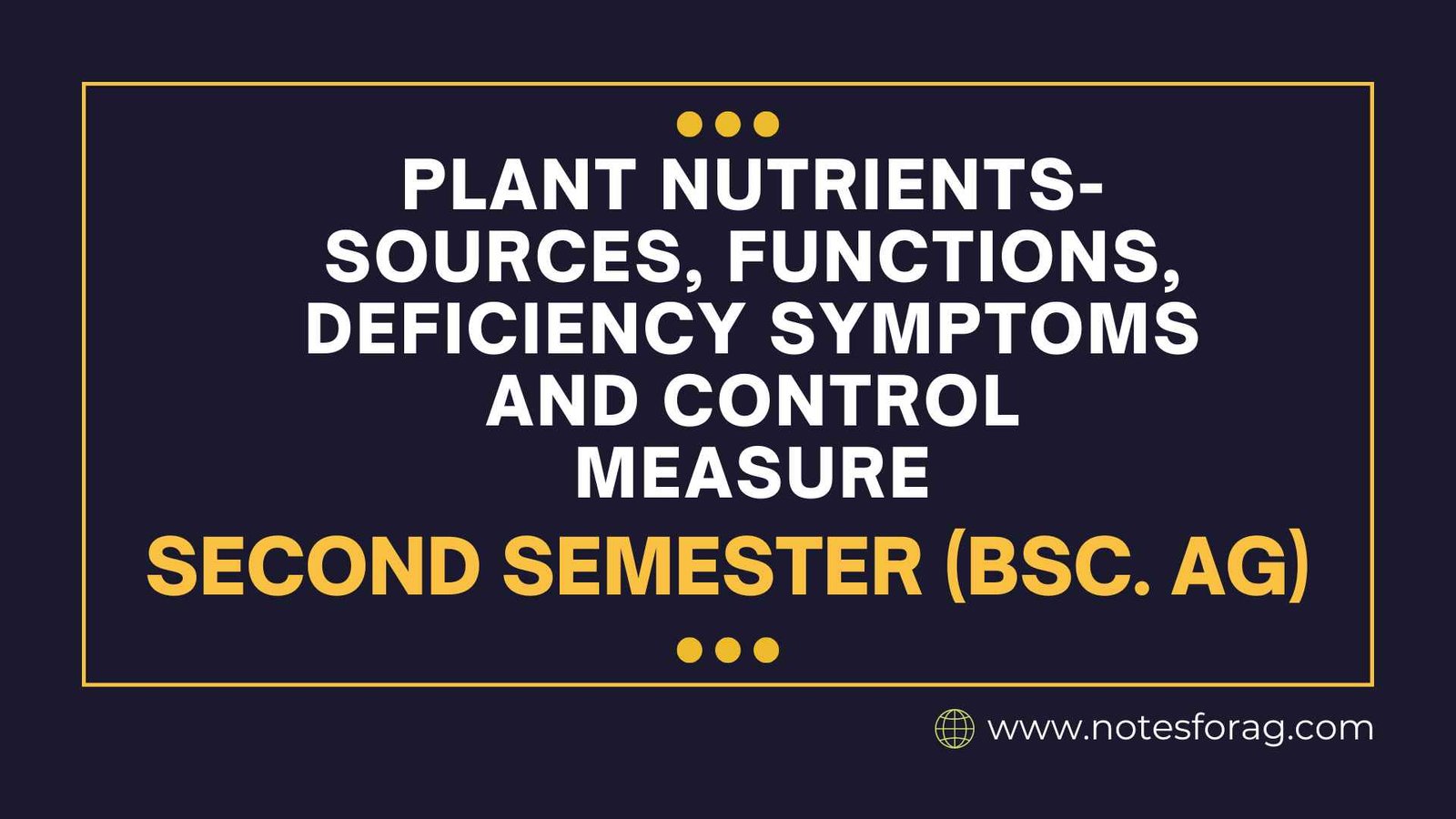Plant Nutrients are vital components needed for growth, development, and reproduction. They are divided into three groups: micronutrients (iron, manganese, zinc, copper, boron, and molybdenum), secondary nutrients (calcium, magnesium, and sulfur), and macronutrients (nitrogen, phosphorus, and potassium). In plant processes like photosynthesis, enzyme activation, and protein synthesis, each nutrient has a distinct purpose. The symptoms of deficiencies range from poor fruit and flower development to yellowing of the leaves and stunted growth. To guarantee a balanced nutrient supply and preserve soil health, control measures include the application of suitable fertilizers, soil pH management, and incorporation of organic matter.
Table of Contents
Introduction to Plant Nutrients

Promoting healthy growth and development of plants requires an understanding of the essential nutrients that plants require. Plants require a balanced diet of certain nutrients, which are divided into macro- and micronutrients. Elements like potassium, phosphorus, and nitrogen are examples of macronutrients, which are needed in greater amounts. Numerous physiological processes, including cell division, energy transfer, and photosynthesis, are significantly impacted by these elements.
Nitrogen is an essential element for plant growth because it is needed for the synthesis of proteins, amino acids, and chlorophyll. Phosphorus is necessary for root growth and flowering and is involved in the energy transfer process through adenosine triphosphate (ATP). Conversely, potassium controls the uptake of water, the activation of enzymes, and the general health of plants, improving their ability to withstand disease and stress.
These nutrients have a variety of natural sources. Plants receive both macro and micronutrients from the soil, which is their primary source. The organic matter, composition, and past farming techniques all affect the soil’s nutrient content. Organic matter increases the fertility of the soil by enriching it with vital nutrients, such as manure and decomposed plant matter. In order to guarantee that plants receive an adequate supply of all essential elements, fertilizers are also frequently used to supplement the soil’s nutrient content.
Sources of Plant Nutrients
For plants to grow and develop healthily, nutrients come from a variety of sources. Organic materials that release nutrients gradually during decomposition, such as crop residues, compost, and manure, are examples of natural sources. Like legumes, cover crops and green manures enrich the soil with organic matter and nitrogen. Phosphorus and calcium are found in minerals such as rock phosphate and limestone, respectively. Plants can easily access nutrients from synthetic fertilizers like potassium sulfate and ammonium nitrate. Furthermore, supplementary soil amendments such as gypsum and Epsom salts provide vital micronutrients and secondary nutrients. These various nutrient sources support strong plant health and soil fertility maintenance.
Functions of Essential Plant Nutrients
Essential nutrients for plants are vital to their overall health, growth, and development. Every nutrient is essential to many different physiological and biochemical processes. Crop yields can be increased and plant care optimized with an understanding of these functions.
1. Nitrogen (N):
An essential part of chlorophyll, the molecule that drives photosynthesis, is nitrogen. Because it contributes to the synthesis of proteins, enzymes, and amino acids, it is essential for leaf growth. Chlorosis, or stunted growth and yellowing of the leaves, is a common symptom of nitrogen deficiency.
2. Phosphorus (P):
In plants, phosphorus is essential for the transfer of energy. It is a part of adenosine triphosphate, or ATP, which is the fuel for numerous metabolic processes. Additionally, phosphorus promotes flowering and root development. Poor root growth and dark green foliage are signs of deficiency.
3. Potassium (K):
In plant cells, potassium controls the uptake of water and the osmotic balance. It is necessary for increasing disease resistance, promoting photosynthesis and enzyme activation, and boosting general plant vigor. A potassium deficit manifests as browning and curling of the leaf margins.
4. Micronutrients:
Iron (Fe), manganese (Mn), and zinc (Zn) are examples of micronutrients that are important for plant health, despite being needed in smaller quantities. Manganese aids in enzyme activation and photosynthesis, while iron is essential for the synthesis of chlorophyll. The synthesis of growth hormone and internode elongation depend on zinc. Micronutrient deficiencies can cause a variety of symptoms, such as reduced growth, leaf malformation, and interveinal chlorosis.
Deficiency Symptoms of Plant Nutrients

For plants to remain healthy and produce large amounts of food, it is essential to identify nutrient deficiencies in plants. Specific roles are played by different nutrients in plant growth, and deficiencies in these nutrients can cause a wide range of symptoms. Early diagnosis and treatment of the problem can be facilitated by recognizing these symptoms.
1. Chlorosis:
This is a prevalent ailment linked to deficiencies in a number of important nutrients, such as magnesium, iron, and nitrogen. In cases of nitrogen deficiency, chlorosis is characterized by a yellowing of the leaves; in contrast, iron deficiency usually affects the younger leaves. Plants with insufficient amounts of magnesium may exhibit interveinal chlorosis, a condition in which the veins stay green but the tissue in between them becomes yellow.
2. Stunted growth:
This may be a sign of insufficient calcium, phosphorus, or potassium. Dark green or purplish leaves and sluggish growth are common symptoms of phosphorus deficiency. Plants that are lacking in potassium may show signs of weak stems and poor root development. Conversely, a lack of calcium can cause stunted or deformed growth, especially in the tips of new leaves and shoots.
3. Necrosis:
This is an additional crucial symptom to be aware of. Deficits in calcium, boron, or potassium may be the cause. Whereas plants lacking in calcium may develop necrotic tips and edges on immature leaves, deficiencies in potassium usually result in necrotic spots along the leaf margins. A lack of boron frequently causes brittle, discolored leaves and the death of growing points.
Plants with deficiencies in certain nutrients are less vibrant and productive overall, in addition to having an impact on how they look. For example, low levels of nitrogen can hinder the production of chlorophyll, which in turn results in poor photosynthesis and decreased crop yields. Likewise, inadequate potassium levels can erode plants’ defenses against illnesses and environmental stressors, endangering their health even more.
Control Measures for Nutrient Deficiencies
Some of the control measures for Nutrient Deficiencies are given below:
1. Soil Testing:
- Test the soil frequently to find out its pH and nutrient levels.
- Utilize the findings to modify your fertilization and amendment plans in order to address particular deficiencies.
2. Balanced Fertilization:
- Use fertilizers that replenish the nutrients that are lacking.
- Make use of balanced fertilizers that are composed of both macro and micronutrients.
- To prevent overfertilization, use the recommended application rates.
3. Organic Amendments:
- Add manure, compost, and other organic materials to the soil to increase its fertility and structure.
- To improve nutrient cycling and add organic matter, use cover crops and green manure.
4. Proper pH Management:
- To increase nutrient availability, keep the pH of the soil at its ideal range, which is typically between 6.0 and 7.0.
- When necessary, apply sulfur to lower pH or lime to raise pH.
5. Efficient Irrigation:
- To promote nutrient uptake, make sure to water your plants regularly and sufficiently.
- Prevent conditions such as drought and waterlogging that can hinder the absorption of nutrients.
6. Mulching:
- Mulch is applied to retain soil moisture, lessen erosion, and contribute organic matter to the decomposing soil.
- Make use of organic mulches, such as grass clippings, leaves, and straw.
Frequently Asked Question(FAQ)
What are plant nutrients?
Plant nutrients are necessary components for the growth, development, and reproduction of plants. The nutrients are arranged into three categories: macronutrients, secondary nutrients, and micronutrients, according to the amounts that plants need.
What is the role of nitrogen in plants?
The synthesis of proteins, amino acids, and chlorophyll depends on nitrogen. It encourages quick development, improves the size and quality of leaves, and increases seed and fruit production.
Related Articles

